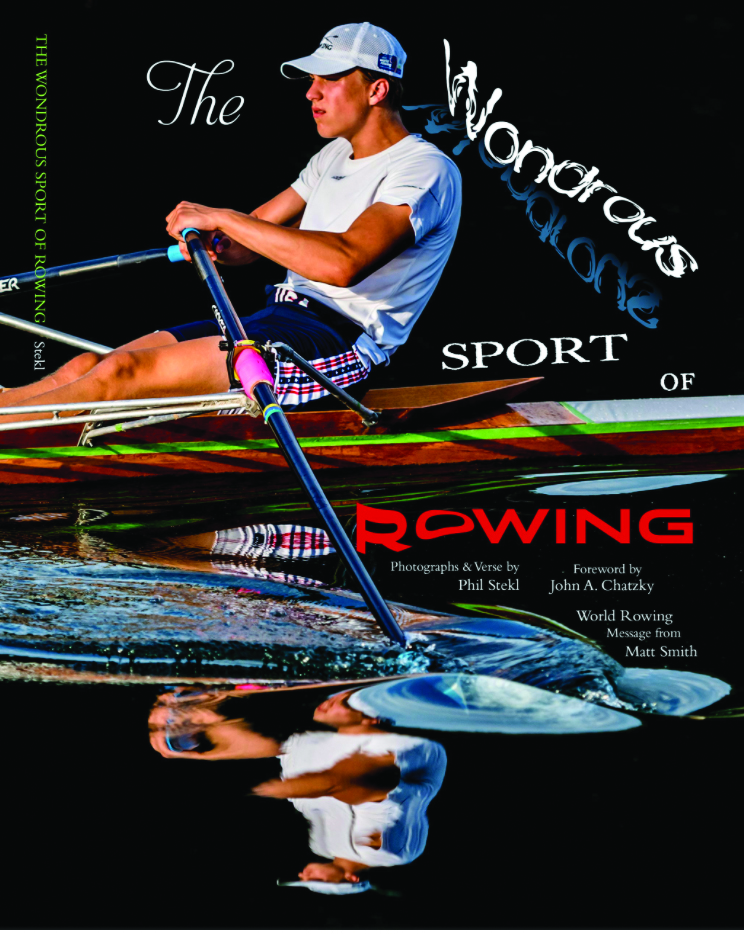BY ANDY ANDERSON
PHOTO PROVIDED
To continue reading…
This article is exclusively for Rowing News subscribers. For as little as $5 a month, you can get access to the best quality, independent reporting on all the issues that matter to the North American rowing community.
Already a subscriber? Login
Doctor Rowing gets asked to review a lot of rowing books. It’s a pleasure to see how many thoughtful, intriguing books have been coming out in the past few years. So when my editor asked, “Would you like to review a book by Phil Stekl?” I didn’t need to think too hard.
Of course I would. Stekl was a Hartford-area legend, a guy who learned to row at Middletown High School, went on to great success at Penn, and then made the 1980 and 1984 Olympic teams. In those 1984 Olympics, he won a silver medal in the coxless four.
His book is The Wondrous Sport of Rowing (available from Amazon), and it’s not at all what you might expect from an Olympian. The text is spare and given to whimsical rhyme, jokes, and to the children’s game “I spy with my little eye.” No reliving of his greatest races or disappointments, no inside scoops on how he was able to rule the erg. (Stekl was famous for rowing the iron beast without histrionics or impassioned grunting. It was commented upon that for him it looked like a day at the office.)
After a career in finance, Stekl returned to another passion–photography. He acknowledges his debt to his father, a photographer for the Middletown, Conn., newspaper, in the preface: “Harnessing the power of images to highlight fellowship is a notion gifted to me by my late father.” And this book is a paean to the fellowship within rowing, of the family that we rowers belong to. “Virtually everything good that’s happened in my life has happened because of rowing,” Phil told me when we talked via Zoom.
“I met my wife, Inge, at the 1978 Worlds in New Zealand, where she was rowing for Austria. My relationships with people of quality met through rowing, my relationship with nature, equipment, water, job opportunities–so much stems from rowing.”
The photographs are beautiful. Whether it’s the opening pages, where one sees only the stern of a single slipping through the water, the magnificent images of a lone single sculler on the Millstättersee, a pristine lake in southern Austria, or the majesty of the Bled racecourse, Stekl’s images invite us into a deep gaze, to immerse ourselves in the water. I hadn’t realized the extent to which rowing amplifies the beauty of nature until I let myself get lost in some of these pages. The beauty of the rowing motion is here with shots of the Head of the Charles and the power of a sculler’s puddle, as is the chaos of the starting line at Amsterdam’s Heineken Regatta.
It’s not all about the beauty of rowing. There’s also the humor of the Vienna starting-line area. Anyone who has ever rowed or cycled next to this course on the Danube will smile at the bodies of the naked sun worshippers sprawled on the river bank while competing rowers groan and strain and coaches cycle past. There is even a cross-country skier getting in some land training. There is a terrific sequence of a Riverside Boat Club eight that captures the panic of an ejector crab and the smiles that light up the crew’s faces when he makes it back into their shell. There are several photos with embedded images. Can you find the oarlock in the tree? What about Jim Dietz’s c-shape on the drive? A woman’s name that rhymes with “healer?” These games seem aimed at children, but “it was also my goal to draw the viewer into each photo, to keep you searching for detail,” Stekl says.
It’s clear that Stekl, who moved to Austria 10 years ago and who has coached local crews, finds wonder in virtually everything connected to rowing. I am haunted by one of the first photographs, a rowboat with a bow, weather-beaten and scarred, that looks carved from an ancient tree. It takes me to a primeval place, before the sport of rowing, when people simply wanted to get out onto the water and experience its magic. Stekl does not quote “A River Runs Through It,” the great story by Norman Maclean, but he certainly agrees with the sentiment “I am haunted by waters.”
Having gained so much from water, Stekl is giving back–51 percent of the book’s net proceeds are being donated to the Kafue River and Rowing Centre, the joint initiative of World Rowing and the World Wide Fund for Nature.
This thin volume of photographs and verse is a celebration of the community that we rowers are all a part of. “If you are going to fall into something, what could be better than rowing?” he says. This unique and compelling book makes that case beautifully.

